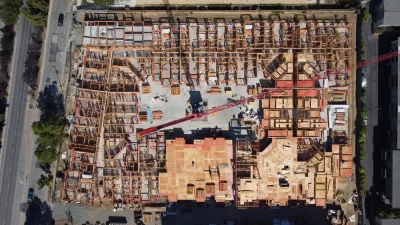Palo Alto, a Silicon Valley city with a history of exclusionary zoning tactics, has produced a new Housing Element that calls for more than 6,000 housing units to be built in the city by 2031.

The city of Palo Alto, California will rely on accessory dwelling units, transit oriented development, and zones previously dedicated to industrial uses in a plan to add 6,000 additional housing units by 2031.
The Silicon Valley’s Housing Element will now be subject to review by state housing authorities as part of the Regional Housing Needs Assessment process that has tripped up numerous municipalities around the state this year. Palo Alto’s Housing Element is one of a wave of similar plans expected around the Bay Area in the coming days and weeks. Southern California cities didn’t do so well with the process, as documented by Planetizen in October, exposing themselves to the new, so-called “Builder’s Remedy,” which forces local governments to forfeit land use control when Housing Elements fail to meet state standards for new housing.
Palo Alto has previously been one of the prime examples of cities in the state of California committed to preventing new density despite proximity to employment centers, making news earlier in 2022 for a strategy to sidestep a recently approved state law, SB 9, by declaring a large swath of the city as a new historic district. The political equation in the city has changed recently, however.
“Getting the state to approve the Housing Element will be a key priority in the coming months for the City Council, which will see three seats turn over to new members. All council candidates and sitting members have named housing as a top priority item, though there is some disagreement over how aggressively the city should strive to meet the state goals,” reports Gennady Sheyner for Palo Alto Online.
According to the article, the proposed Housing Element calls for a regionally mandated 6,038 new homes, in addition to “strategies for preserving existing housing, streamlining the development approval process and promoting affordable housing.” The “most aggressive” of the changes proposed by the Palo Alto’s Housing Element would rezone industrial and commercial areas around San Antonio Road and Fabian Way for residential use.
FULL STORY: Palo Alto releases plan to add more than 6,000 dwellings

Maui's Vacation Rental Debate Turns Ugly
Verbal attacks, misinformation campaigns and fistfights plague a high-stakes debate to convert thousands of vacation rentals into long-term housing.

Planetizen Federal Action Tracker
A weekly monitor of how Trump’s orders and actions are impacting planners and planning in America.

In Urban Planning, AI Prompting Could be the New Design Thinking
Creativity has long been key to great urban design. What if we see AI as our new creative partner?

Car Designs Make it Harder to See Pedestrians
Blind spots created by thicker pillars built to withstand rollover crashes are creating dangerous conditions for people outside vehicles.

Cal Fire Chatbot Fails to Answer Basic Questions
An AI chatbot designed to provide information about wildfires can’t answer questions about evacuation orders, among other problems.

What Happens if Trump Kills Section 8?
The Trump admin aims to slash federal rental aid by nearly half and shift distribution to states. Experts warn this could spike homelessness and destabilize communities nationwide.
Urban Design for Planners 1: Software Tools
This six-course series explores essential urban design concepts using open source software and equips planners with the tools they need to participate fully in the urban design process.
Planning for Universal Design
Learn the tools for implementing Universal Design in planning regulations.
Appalachian Highlands Housing Partners
Gallatin County Department of Planning & Community Development
Heyer Gruel & Associates PA
Mpact (founded as Rail~Volution)
City of Camden Redevelopment Agency
City of Astoria
City of Portland
City of Laramie





























